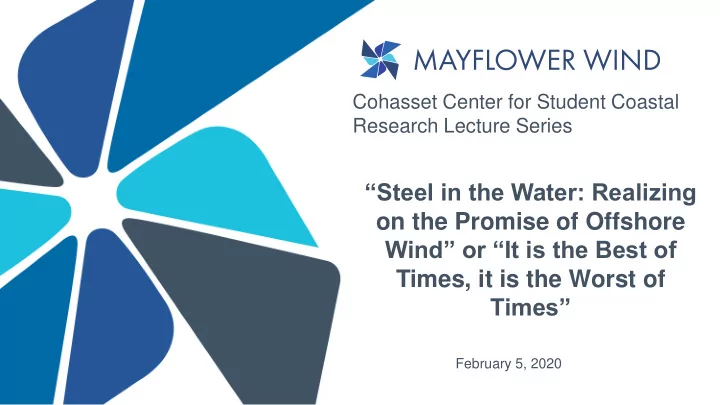

Cohasset Center for Student Coastal Research Lecture Series “Steel in the Water: Realizing on the Promise of Offshore Wind” or “It is the Best of Times, it is the Worst of Times” February 5, 2020
THE CONTEXT
THE CHALLENGE CO2 emissions from Global Carbon Project. Population & GDP data from World Bank. Figure prepared by Zeke Hausfather https://erg.berkeley.edu/people/hausfather-zeke/
What needs to be done . . . Many experts say this is still Business As Usual (BAU) trajectory Some experts say this is now BAU
Bending this curve will require a total change to our energy system – but we have done it before . . . New Bedford: “The city that lit the world” Casks of whale oil. Photo courtesy: New Bedford Whaling Museum/ NPS
Where did our energy come from back in 2000?
And in 2018
The role of electricity in other sectors: new Bernstein analysis 8
. . . And specifically what is happening in New England . . .
Recent estimate of new generation needed to meet New England climate goals, commissioned by solar industry 10
What is in the “queue” of projects planning to join our regional electricity system? The big footprint of planned offshore wind plugging into MA Directionally encouraging but the numbers need to get MUCH bigger But how do these things work? (segue alert)
How do Offshore Windfarms work? A simple schematic 12
The (theoretical) process for developing an offshore wind in U.S. Federal Waters Timeline from brand new AWEA Public Participation Guide for Offshore Wind 13
OFFSHORE WIND PERMITTING PROCESS (FEDERAL & MA) ▪ Project path driven by Federal State local, state and federal USACE EPA USCG BOEM FAA MEPA MA EFSB/DPU regulatory approval times CZM/CRMC Petition ▪ ENF Federal process is complex COP National Environmental Policy Act EFSB Scoping and evolving – needs to be comprehensive Endangered Species Act NEPA siting approval Scoping ENF National Historic Preservation Act process updated Certification incorporates Migratory Bird Treaty Act roughly 12+ DEIS ▪ Legacy state infrastructure/ State and 12+ DEIR Magnuson-Stevens Fishery Local permits or FEIS Conservation Management Act approvals energy siting process must DEIR Marine Mammal Protection Act Certification ROD be adapted to this new Coastal Zone Management Act FEIR FDR/FIR technology Clean Air Act Final MEPA ▪ Clean Water Act Certification EFSB Final Local engagement is Decision Rivers & Harbors Act Regional Commissions (DRI) critical for long term Town Town Road success Conservation Opening Commissions / ZBAs 14
Where will these Offshore wind projects go? 15
MAYFLOWER WIND PROJECT AS EXAMPLE Mayflower Wind is a joint venture of Shell New Energies (50%) and EDP Renewables (50%). We are backed by the combined capability, experience, commitment to innovation, and financial strength of a world-leading offshore energy developer and a world-leading wind power and renewable energy developer. Shell New Energies US LLC CORE VALUES ▪ Safety first, safety always. We are committed to treating our people, community, and environment with care. ▪ Innovation and Industry Development. We expect innovation will continue to drive the rapid decline in the cost of wind energy and aim to be a leader in this space. ▪ Investing in Communities. We are committed to building responsible partnerships with local communities by supporting jobs, economic development, and innovation that will flourish for decades to come. 16
MAYFLOWER WIND SITE Location: Atlantic Coast Outer Continental Shelf ▪ Lease: OCS-A 0521 ▪ Area: 127,000 acres (520 km 2 ) ▪ ▪ Water Depth: 64% < 55m ▪ 36% > 55m ▪ Average wind speed at 135m : 10.1m/s Distance to shore: 85-105 km ▪ Connection point: Bourne, MA ▪ ▪ Distance to grid connection: 125 km ▪ Potential: up to 1,600 MW (depending on technology) 17
BUT over 80% A tale of many possible foundation types . . . of existing offshore wind use monopiles Other technologies are more expensive but water depths may dictate moving beyond that technology Also pile driving sound is a construction period impact that currently needs to be carefully managed 18
Offshore Wind technology – Past (Horns Rev) 19
Offshore Wind technology – Present (Hornsea One off Britain) 20
Offshore Wind technology – Future (Windfloat Atlantic off Portugal) – will be needed for deeper water like West Coast and Gulf of Maine And in- between, jackets (like Block Island) could fill the gap 21
The unique West Coast challenge: The Navy map . . . 22
The next frontier for New England Offshore Wind? 23
Thank You Questions? Comments? Visual detection (Common dolphin) 12 August 2019 24
Recommend
More recommend